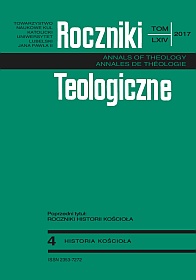Rigorism and Moral Laxity in Early Christian Heretical Movements: On the Basis of Diversarum Hereseon Liber of Philastrius of Brescia
Abstract
The objective of the article is to illustrate the two extremes represented by the broad assortment of movements: the ascetic rigorism and moral laxity. The primary source of text is the first Latin catalogue of heresies, written between 380 and 388 by the Bishop of Brescia, Philastrius. The source selection was dictated on twofold grounds. The treaty contains the most numerous descriptions of heretical groups, yet at the same time is the least known of its kind. The information enclosed in Philastrius' work, summarized in a comparative manner with the descriptions found in other patristic catalogues of heresy – by Epiphanius, Theodoret of Cyrus, John Damascene, Augustine and Isidore of Seville – lead to the following conclusions: 1) for the most part heretical movements followed the ascetic radicalism, motivated most habitually by an exaggerated literal exegesis of the biblical texts (eg. Gnostics, Encratites, Discalced); 2) the few of the laxative-approach movements operated on moral promiscuity (eg. Simonians, Carpocratians, Symmachians), the extent of which is difficult to assess due to the raised issues with the objectivity of Philastrius’ work – undermined by the use of invectives and the apologetic attitude of the author employed in order to defend the orthodox doctrine and morals; 3) paradoxically, there existed also groups that combined inconsistently promiscuity with the elements of asceticism (eg. Borborites, Adamites).
References
Banterle G., Introduzione, w: Filastrius Brixiensis, Diversarum hereseon liber, ed. F. Heylen, G. Banterle, Scriptores circa Ambrosium 2, Milano–Roma, Città Nuova Editrice, Biblioteca Ambrosiana 1991, s. 9-18.
Bardy G., Le „De haeresibus” et ses sources, w: Miscellanea agostiniana: testi e studi, t. II, Roma: Tipografia poliglotta vaticana 1931, s. 397-416.
Boulluec A. Le, La notion d’hérésie dans la littérature grecque (IIe et IIIe siècles), t. I-II, Paris: Études Augustiniennes 1985.
Dobkowski M., Augustyn i jego wiedza na temat manicheizmu, „Studia Religiologica” 46(2013), nr 1, s. 55-63.
Fiedrowicz M., Teologia Ojców Kościoła. Podstawy wczesnochrześcijańskiej refleksji nad wiarą, tłum. W. Szymona, Kraków: Wydawnictwo Uniwersytetu Jagiellońskiego 2009.
Gilski M., Epifaniusz z Salaminy i jego „Panarion”, w: Epifaniusz z Salaminy, Panarion. Herezje 1-33. Tekst grecki i polski, przekład i wstęp M. Gilski, opracowanie i komentarz A. Baron, Kraków: Wydawnictwo Naukowe Uniwersytetu Papieskiego Jana Pawła II 2015, s. 5-20.
Grossi V., Eresia – Eretico, w: Dizionario Patristico e di Antichità Cristiane, t. I, red. A. Di Berardino, Genova: Casa Editrice Marietti – Casale Monferrato 1983, k. 1187-1191.
Guibert J. De, La notion d’hérésie chez s. Augustin, „Bulletin de littérature ecclésiastique” 21(1920), s. 369-382.
Guillaumont A., U źródeł monastycyzmu chrześcijańskiego, tłum. S. Wirpszanka, t. I, Źródła Monastyczne 37, Kraków: Tyniec Wydawnictwo Benedyktynów 2006.
McClure J., Handbooks against Heresy in the West, from the Late Fourth to the Late Sixth Centuries, „The Journal of Theological Studies. New Series” 30(1979), s. 186-197.
Moutsoulas E., Der Begriff „Häresie” bei Epiphanius von Salamis, „Studia Patristica” 7(1966), s. 362-371.
Poschmann B., Paenitentia secunda. Die kirchliche Busse im ältesten Christentum bis Cyprian und Origenes, Bonn: Hanstein 1940.
Stachura M., Heretycy, schizmatycy i manichejczycy wobec cesarstwa rzymskiego (lata 324-428, wschodnia część Imperium), Kraków: Towarzystwo Wydawnicze „Historia Iagellonica” 2000.
Szram M., Cnota pokory w nauczaniu greckich Ojców Kościoła IV wieku, Lublin: Wydawnictwo KUL 2014.
Widok N., Ortodoksja, herezja, schizma – wyjaśnienie pojęć, w: Ortodoksja, herezja, schizma w Kościele starożytnym, red. F. Drączkowski, J. Pałucki, P. Szczur, M. Szram, M. Wysocki, M. Ziółkowska, Lublin: Wydawnictwo Polihymnia 2012, s. 15-34.
Young F.M., Did Epiphanius know what he meant by Heresy?, „Studia Patristica” 17(1982), nr 1, s. 199-205.
Zagórski D., Jak posiadać, by nie przekroczyć miary? Realizacja ideału „mesotes” w posługiwaniu się dobrami materialnymi według Klemensa Aleksandryjskiego, w: Historia świadectwem czasów, red. W. Bielak, S. Tylus, Lublin: Wydawnictwo KUL 2006, s. 599-612.
Zagórski D., Recepcja Arystotelesowskiego ideału „mesotes” w doktrynie Klemensa Aleksandryjskiego. Problem definicji, „Roczniki Teologiczne” 51(2004), nr 4, s. 5-42.
Zawadzki W., Bernhard Poschmann – warmiński badacz wczesnochrześcijańskiej pokuty, Olsztyn: Wydawnictwo Wyższego Seminarium Duchowne Metropolii Warmińskiej „Hosianum” 1998.
Copyright (c) 2017 Roczniki Teologiczne

This work is licensed under a Creative Commons Attribution-NonCommercial-NoDerivatives 4.0 International License.





